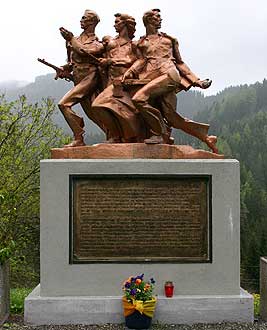 The relatively small capital of Carinthia is littered with memorials. This brochure sets out to shed some discriminating light on Klagenfurt's memorial landscape for visitors of the city as well as to confront people with the city's largely "forgotten" national-socialist history, which continues into the present.
The relatively small capital of Carinthia is littered with memorials. This brochure sets out to shed some discriminating light on Klagenfurt's memorial landscape for visitors of the city as well as to confront people with the city's largely "forgotten" national-socialist history, which continues into the present.To date, Carinthia's historiography has been heavily marked by German nationalism on the one hand and anti-Slav sentiments on the other. It revolves around what is known as the Kärntner Abwehrkampf (Carinthian defence fight): After World War I had ended a border conflict, not unusual for the day, led to a people's referendum in which the majority of the people of the disputed area of South Carinthia chose to stay under Austrian sovereignty on 10 October 1920, mainly for economic reasons. Anti-Slav sentiments and the German-nationalist ideology proved fertile soil for national-socialist organisations, which soon began to sprout up in Carinthia. Thus, the 1938 Anschluss (the 1938 "annexation" of Austria into "Greater Germany" by the Nazi regime) did not constitute a rupture of any kind in Carinthian history. Nazi ideologies presented a logical continuation for the region and its population of whom many were already active in Nazi organisations. A history that, even after the liberation by the Allies in 1945, would continue: as soon as the 1950s, many former national-socialists were reinstated and they soon returned to positions of high social and political standing. This coincided with the erection of a lot of revisionist memorials commemoriating the "victims" – on the national-socialist side – of World War II. In stark contrast, the victims of the national-socialist regime of terror received little to no attention. Erecting memorials for these victims often took years of struggle on the part of anti-fascist movements. Today, anti-fascist memorials continue to be targets of desecration, whereas German-nationalist symbols still form the centre of grandiose celebrations.
Because listing all the memorials in Klagenfurt/Celovec would have been impossible, we want to mention the few anti-fascist memorial sites that exist in Carinthia today: The memorial commemorating the victims of the Nazi Euthanasia Programme on the premises of the State Hospital Klagenfurt, the memorial for the victims of national-socialism on St. Veiter Ring in front of the Slovenian cultural house Hermagoras, the memorial for the resistance fighters against the national-socialists and the victims of national-socialism at the Annabichl cemetery, the memorial for the victims of national-socialism in front of the University of Klagenfurt and the memorial for the Carinthian partisans on Peršmanhof.
* We want to raise the issue of nazi perpetration history, which without fail disregards its victims, for each stone-hewn instance of it.
* We want to call attention to places that, by remembering victims and the Nazi perpetrations, prevent both from being forgotten!
How to read this city guide:
This brochure covers three topical sections
* German nationalist/far-right wing memorials
* Sites of national-socialist terror
* Jewish Klagenfurt/Celovec
Each section is numbered. There are three suggestions for city walks through Klagenfurt, corresponding to the different numbers.
Our city walk is most certainly not intended to aid digestion!